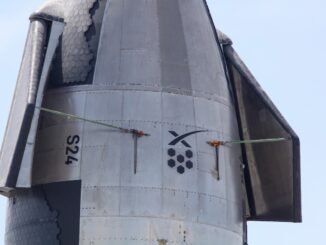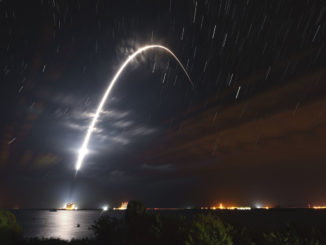STORY WRITTEN FOR CBS NEWS & USED WITH PERMISSION

Closing out an automated 18-hour rendezvous, a SpaceX Dragon cargo ship loaded with 7,000 pounds of supplies and equipment, including two add-on roll-out solar blankets, caught up with the International Space Station early Tuesday and moved in for a problem-free docking.
Flying through orbital darkness 270 miles above the southern tip of South America, the unpiloted Dragon, launched Monday from the Kennedy Space Center, approached the lab from behind and below, looping up in front of the station and then on to a point about 600 feet directly above the forward Harmony module’s space-facing port.
From there, the Dragon moved straight in for docking at 5:54 a.m. EDT. Hooks then closed to firmly lock the craft in place, clearing the way for the station crew to open hatches later in the day to gain access to about 4,000 pounds of supplies, science gear and other equipment.
Housed in the Dragon’s unpressurized lower trunk section were two ISS roll-out solar array blankets, or IROSAs, the fifth and sixth to be added to the station to augment the lab’s aging solar panels. The arrays and their support hardware tipped the scales at about 3,000 pounds.
The two new IROSAs will be pulled out of the Dragon’s open trunk by the station’s robot arm Thursday and mounted near the right end of the station’s solar power truss. Astronauts Steve Bowen and Woody Hoburg plan to install and extend the first 63-foot-long blanket during a spacewalk Friday and the second during another spacewalk next Thursday.
The space station is equipped with four primary solar array wings, two on each side of the power truss. Each wing is made up of two 39-foot-wide blankets extending 112 feet in opposite directions. The first two-blanket wing was launched in December 2000 with additional pairs delivered in 2006, 2007 and 2009.
Solar cells degrade over time and NASA is adding six IROSAs, at a cost of $103 million, to the existing power system. Each 20-foot-wide roll-out blanket is attached to the base of an already existing array, each generating more than 20 kilowatts of power.
Even though the IROSAs block portions of the underlying arrays from the sun, the station’s upgraded system will provide about 215,000 watts of power overall, roughly equivalent to the output the original arrays generated when they were new.
NASA plans to order a final two IROSAs in the near future to provide the power needed to support agency-sponsored research, anticipated commercial activity and the addition of one-or-more commercial modules between now and the station’s retirement at the end of the decade.



